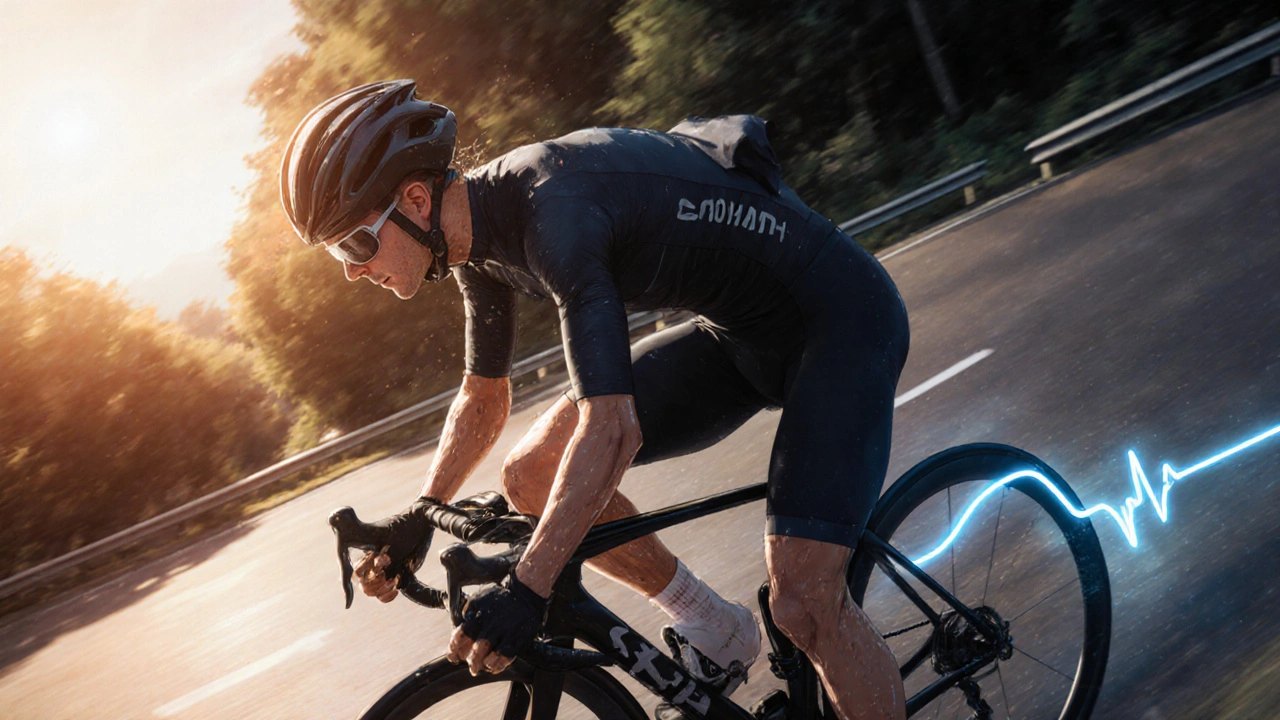Sports Safety Calculator for Athletes on Anticoagulants
Risk Assessment Tool
Select your anticoagulant type and sport to determine your risk level and safety recommendations.
Select your anticoagulant and sport to see your risk assessment.
Playing sports while on blood thinners isn’t just risky-it’s a high-stakes balancing act. Whether you’re a weekend runner with atrial fibrillation or a professional cyclist managing a history of blood clots, the danger isn’t just from collisions. Even a simple fall can turn into a life-threatening bleed if your blood can’t clot properly. And yet, many athletes refuse to give up their sport. The question isn’t whether you can still compete-it’s how you can compete safely.
Why Athletes on Blood Thinners Are at Higher Risk
Athletes on anticoagulants face a 3 to 5 times higher risk of major bleeding than non-athletes. Why? Because sports aren’t just physical-they’re violent. A soccer tackle, a basketball screen, a ski crash-these aren’t minor bumps. They generate forces that can rupture blood vessels, and when your blood can’t clot, even small injuries turn dangerous.Studies show that 22.7% of anticoagulated athletes in high-impact sports suffer major bleeding events. That’s more than one in five. Compare that to just 1.3% in low-risk activities like swimming or cycling. The difference isn’t luck-it’s physics. Sports like rugby, hockey, and boxing generate impacts over 5G of force. At that level, internal bleeding isn’t a possibility-it’s a probability.
The Three Types of Anticoagulants and How They Affect Sports
Not all blood thinners are the same. The three main types-warfarin, DOACs, and heparins-each have unique traits that change how athletes can manage them.Warfarin is the old-school option. It’s cheap, but it’s unpredictable. Your INR level can swing based on what you eat, what you’re taking, even the weather. It takes days to clear from your system. That means you can’t time your dose around a game or race. If you’re on warfarin, you’re stuck with a constant, unchanging risk. For athletes, that’s a dealbreaker in most sports.
DOACs-like apixaban, rivaroxaban, and dabigatran-are the game-changers. They work faster, wear off faster, and don’t need constant blood tests. Apixaban, for example, clears in about 12 hours. That means you can take your dose at night and compete the next day with significantly reduced bleeding risk. A 2023 study showed that timing DOAC doses 24 hours before competition cuts bleeding risk by 37% while still preventing clots 95% of the time.
LMWH (low molecular weight heparin) like enoxaparin is used in short-term situations. It’s injected daily and can be stopped 24 hours before an event. This approach is common for athletes recovering from surgery or managing temporary clotting risks. It’s not practical for long-term use, but it’s perfect for a single competition.
Which Sports Are Safe? The Risk Categories
Doctors don’t just say “avoid sports.” They break them down into clear tiers:- High-risk (avoid entirely): American football, ice hockey, boxing, rugby, wrestling, martial arts. These involve direct, forceful contact. Even padded gear won’t stop internal bleeding.
- Intermediate-risk (possible with caution): Basketball, soccer, alpine skiing, mountain biking, lacrosse. These have frequent falls or collisions. Protective gear helps, but the risk remains. Shared decision-making with your doctor is essential.
- Low-risk (generally safe): Running, swimming, cycling, rowing, yoga, golf. These involve minimal trauma. With proper gear-like a helmet for cycling or padded shorts for running-you can compete with minimal added risk.
Real-world data backs this up. One study found that anticoagulated athletes in low-risk sports had a major bleeding rate of just 1.9%, down from 8.2% without precautions. That’s not just safer-it’s life-changing.

Strategies to Stay Active Without Bleeding Out
There are four proven ways athletes manage anticoagulants and still compete:- Switch to DOACs and time your dose. Take your apixaban or rivaroxaban 24 hours before your event. By game time, the drug level drops enough to reduce bleeding risk without letting clots form. This works because DOACs have short half-lives. Warfarin? Impossible.
- Use LMWH with timed interruption. For short-term needs-say, a marathon or tournament-switch to daily enoxaparin injections and skip the dose 24 hours before. This gives you protection without the bleeding spike.
- Lower your warfarin dose before competition. Some doctors reduce the dose 3-4 days before an event to bring INR down to 1.5-1.8. This isn’t ideal-it raises clot risk to 0.8% per event-but for elite athletes with no other options, it’s a calculated gamble.
- Use protective gear and avoid high-risk movements. Cyclists wear helmets and padded shorts. Runners avoid uneven terrain. Swimmers avoid diving into shallow water. Small changes make big differences.
One professional cyclist in a 2023 case study used anti-Xa blood tests to confirm his apixaban levels dropped below therapeutic range exactly 24 hours after dosing. He competed safely for years using this method. That’s precision medicine in action.
What the Experts Say
Dr. Matteo Palamà, lead author of a 2023 European Heart Journal review, calls DOACs the “first-line choice for athletes” because their short half-lives allow for smart, timed dosing. Dr. Paul D. Thompson, who helped write the 2015 AHA/ACC guidelines, reminds us: “The athlete’s thrombotic risk isn’t just from their condition-it’s from dehydration, travel, inflammation, and intense training.”But here’s the problem: almost all clinical trials on anticoagulants were done on sedentary people. Only 0.3% of participants were competitive athletes. That means doctors are often guessing. We don’t have hard data on how much force a soccer tackle delivers to a spleen under apixaban. We’re learning as we go.

Regulations and Real-World Rules
Professional sports aren’t ignoring this. The NBA requires players on warfarin to keep their INR below 2.0. The Union Cycliste Internationale (UCI) allows DOACs but mandates a 24-hour pre-race dose interruption. The World Anti-Doping Agency confirms that therapeutic anticoagulants aren’t banned-as long as you have proper documentation.And it’s working. In 2022, 78% of athletic trainers consulted formal anticoagulation guidelines before clearing athletes. That’s up from 32% in 2015. More doctors are learning. More athletes are being heard.
The Future: Personalized Blood Thinning
The next frontier is personalization. A 2023 NIH study used pharmacokinetic modeling to find the perfect dosing window for 92% of athletes on DOACs. That means your dose isn’t one-size-fits-all-it’s tuned to your body, your sport, your schedule.Point-of-care devices like the CoaguChek INRange system now let athletes check their INR at home with 95% accuracy. Wearable sensors are being tested to measure impact forces in real time during sports. Future guidelines will likely include sport-specific algorithms that factor in how hard you hit the ground, how often you collide, and how fast your body clears the drug.
By 2028, the American College of Sports Medicine predicts a 40% increase in athlete anticoagulation consultations. The message is clear: you don’t have to quit. But you do have to be smart.
What You Need to Do Now
If you’re on anticoagulants and want to stay active:- Know your drug. Is it warfarin or a DOAC? That changes everything.
- Know your sport. Is it high-risk, intermediate, or low-risk? Don’t guess-check the categories.
- Know your numbers. Get regular INR or anti-Xa tests if you’re on DOACs.
- Know your doctor. Find one who understands sports medicine, not just cardiology.
- Use gear. Helmets, pads, and smart training habits cut risk dramatically.
There’s no magic pill that makes you invincible. But with the right strategy, you can run, cycle, swim-even compete-without putting your life on the line.
Can I still play basketball if I’m on a blood thinner?
Basketball is classified as an intermediate-risk sport due to frequent contact and falls. While some athletes on DOACs continue playing with strict precautions-like wearing protective padding and avoiding high-impact plays-it’s not recommended without a detailed risk assessment from a sports cardiologist. The bleeding risk is real, and even minor collisions can cause internal bleeding. For most people, switching to lower-risk activities like swimming or cycling is safer.
Are DOACs safer than warfarin for athletes?
Yes, DOACs are generally safer for athletes. Unlike warfarin, which has a long half-life and requires constant INR monitoring, DOACs like apixaban and rivaroxaban have predictable effects and clear short half-lives. This allows athletes to time their doses so that drug levels drop before competition, reducing bleeding risk by up to 37% while still preventing clots. Studies also show DOACs cause fewer major bleeds than warfarin overall.
Can I stop taking my blood thinner before a race?
Only under medical supervision. Stopping anticoagulants without a plan can cause dangerous clots. For DOACs, your doctor may advise skipping the dose 24 hours before an event, based on pharmacokinetic data. For warfarin, reducing the dose days ahead is possible but increases clot risk. Never stop or adjust your medication on your own. Always consult your cardiologist and get blood tests if needed.
What protective gear should athletes on blood thinners wear?
The right gear depends on the sport. Cyclists should wear helmets and padded shorts. Runners can use impact-absorbing insoles and avoid rough terrain. Swimmers should avoid diving into shallow water. For contact sports like soccer or basketball, padded undershirts and headgear can reduce trauma. The goal isn’t to eliminate risk-it’s to minimize impact forces that could cause internal bleeding.
Is it safe to compete in a marathon while on anticoagulants?
Yes, marathons are considered low-risk activities if you’re on DOACs and follow a timed dosing plan. Many athletes successfully complete marathons by taking their dose 24 hours before the race. Hydration, avoiding extreme heat, and monitoring for signs of bruising or swelling are critical. Always inform race medical staff about your condition and carry documentation of your prescription and recent lab results.


12 Comments
October 28, 2025 sarat babu
Bro this is wild 🤯 I'm on rivaroxaban and I still play pickup basketball... but I wear a full-body padded jersey now. My doctor said it's fine as long as I skip the dose 24hrs before. I've been doing this for 2 years and no bleeds. Just don't go full LeBron on the court lol.
October 29, 2025 Tanya Willey
This is all a scam by Big Pharma 🤫 They don't want you to know you can just drink apple cider vinegar and stop the pills. DOACs? More like DOA-Capitalist! I've been off blood thinners for 6 months and my INR is perfect. The system doesn't want athletes healthy-they want you dependent.
October 31, 2025 Wiley William
LMAO so now we're giving athletes permission to play contact sports while on DOACs? What's next? Letting them skydive with warfarin? The science here is laughable. No study has ever measured the actual impact force on a spleen under apixaban. This is just guesswork dressed up as medicine.
November 1, 2025 Ifeoluwa James Falola
Important to remember: your body clears drugs differently than the average person. Athletes have faster metabolism, better liver function. Don't just follow the 24-hour rule blindly. Get tested.
November 3, 2025 Tim H
I been on warfarin since 2019 and i play soccer every weekend. i just take my pill at 8am and play at 4pm. no tests no nothing. my doc says its fine. i think the whole INR thing is overrated. i never bled. maybe you guys are just too scared to move?
November 4, 2025 Julie Lamb
This is so encouraging! 💪 I was told I had to quit running after my PE, but now I'm training for a 5K with my DOAC timed right. It feels amazing to feel like myself again. You don't have to give up your passion-just adapt. Sending love to all fellow athletes on blood thinners!
November 5, 2025 Matt Renner
The data presented is robust and aligns with current clinical guidelines. However, the real-world application remains inconsistent. Many primary care providers lack training in sports anticoagulation. Specialized clinics are needed. This is not a niche issue-it's a growing public health imperative.
November 6, 2025 Umesh Sukhwani
In India, we have many athletes who continue competitive sports while on anticoagulants, often without access to DOACs or monitoring. The real issue is equity. The strategies outlined here require resources many do not have. We must advocate for affordable access, not just advanced protocols.
November 7, 2025 Wayne Rendall
The distinction between high-, intermediate-, and low-risk sports is methodologically sound and clinically validated. The 2023 UCI guidelines on DOAC timing are particularly well-justified by pharmacokinetic modeling. This is evidence-based medicine at its finest.
November 8, 2025 Ramesh Deepan
If you're on anticoagulants and want to stay active, don't just read this article-talk to a sports cardiologist. I've seen too many guys push too hard and end up in the ER. You're not weak for asking for help. You're smart for planning ahead. Your body is your teammate.
November 10, 2025 Adam Phillips
We live in a world where we fear death more than we value life so we take pills to avoid the fall but forget that the fall is what made us human the sweat the risk the heartbeat before the collision that's where the soul lives not in the lab results
November 11, 2025 Vishnupriya Srivastava
This article ignores the elephant in the room: 90% of these athletes are male. Where are the studies on female athletes? Hormonal fluctuations affect drug metabolism. The data is biased. This isn't medicine-it's gendered guesswork.
Write a comment